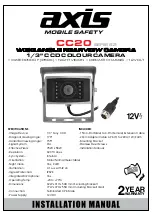
32
|
Positioning the Slave and Remote Flash Units
You can create various professional lighting setups by positioning slave units individually or in groups to
function as main, fill, accent, and other lights. Metering your scene with a handheld light meter and setting
your light ratios to achieve specific looks will give you a professional level of creative control.
When positioning wireless slaves to light a subject, keep in mind the following:
• The effective communication range between master and slave flash units is approximately 33 feet (10 m)
for outdoor use, and up to 49 feet (15 m) when using the flash indoors. These ranges may vary, depending
on the ambient light for the optical communication.
• The flash head should not be aimed directly into the camera lens.
• The wireless optical TTL sensor is located on the front of the VC-310C. Make sure that the sensor is facing
the master flash and that there are no obstructions between the two units.
• When photographing outdoors or in bright ambient light, the optical sensors may be overwhelmed by
ambient light, which will lower their sensitivity.
• To avoid creating interference between flash units, using more than three in a single group is
not recommended.
Using the VC-310C as a Master in the Wireless Multi









































